In early August, more than sixty years ago, a terrible tragedy occurred. Then, for the first time, nuclear weapons were used against civilians. It was a terrible event then, and its dire consequences are felt today. Since that time, there have been many documentary evidences, with some of which we will introduce you.
During World War II, on August 6, 1945, at 8.15 am, an atomic bomb was dropped on Hiroshima, Japan, by a US B-29 "Enola Gay" bomber. About 140,000 people died in the explosion and died over the following months. Three days later, when the United States dropped another atomic bomb on Nagasaki, about 80,000 people were killed. On August 15, Japan surrendered, thus ending World War II.
Until now, this bombing of Hiroshima and Nagasaki remains the only case of the use of nuclear weapons in the history of mankind. The US government decided to drop its bombs, believing that this would hasten the end of the war and that there would be no need for prolonged bloody battles on the main island of Japan. Japan was trying hard to control two islands, Iwo Jima and Okinawa, when the Allies approached.
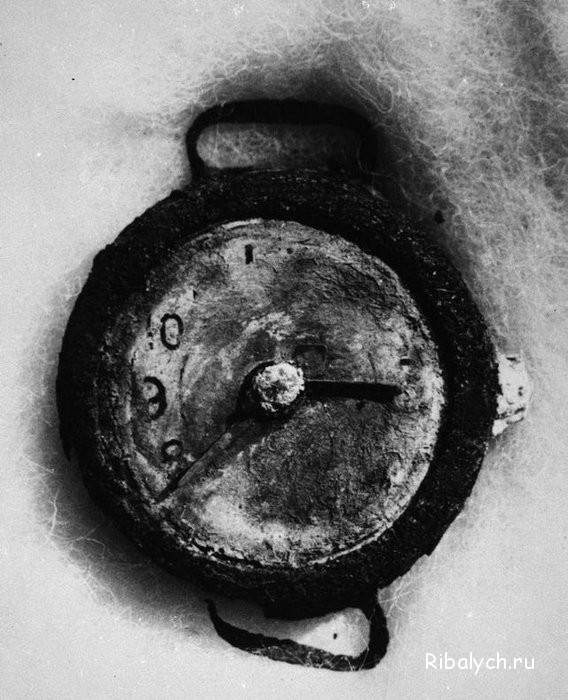
1. These wrist watch found among the ruins, stopped at 8.15 a.m. on August 6, 1945 - during an explosion atomic bomb in Hiroshima.
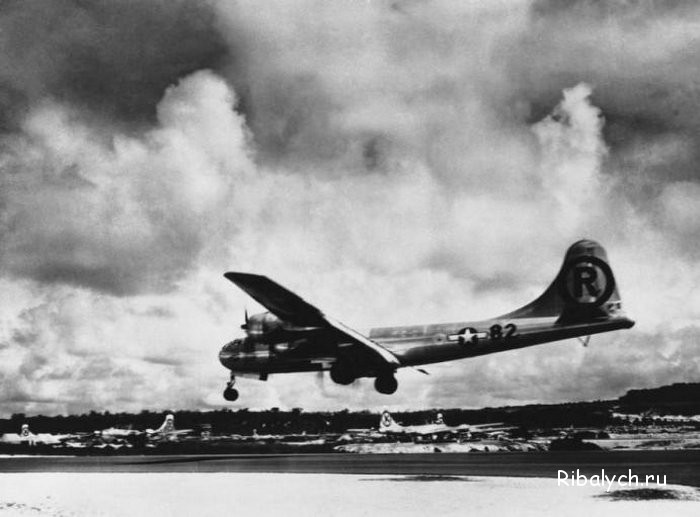
2. Flying fortress "Enola Gay" lands on August 6, 1945 at the base on the island of Tinian after the bombing of Hiroshima.
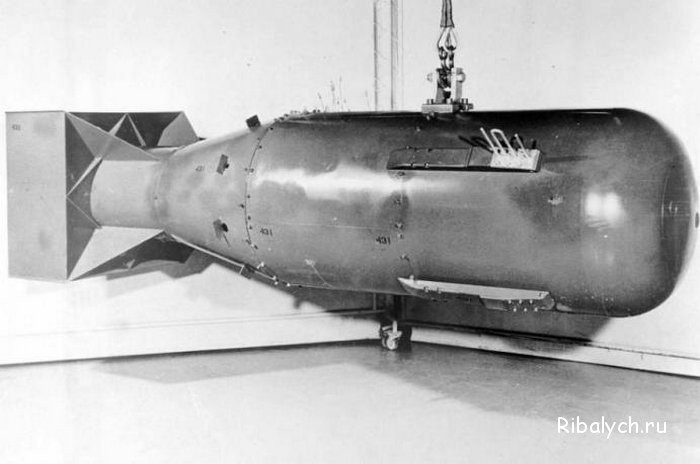
3. This photo, released in 1960 by the US government, shows the Little Boy atomic bomb dropped on Hiroshima on August 6, 1945. The bomb measures 73 cm in diameter and 3.2 m in length. It weighed 4 tons, and the explosion power reached 20,000 tons in TNT equivalent.
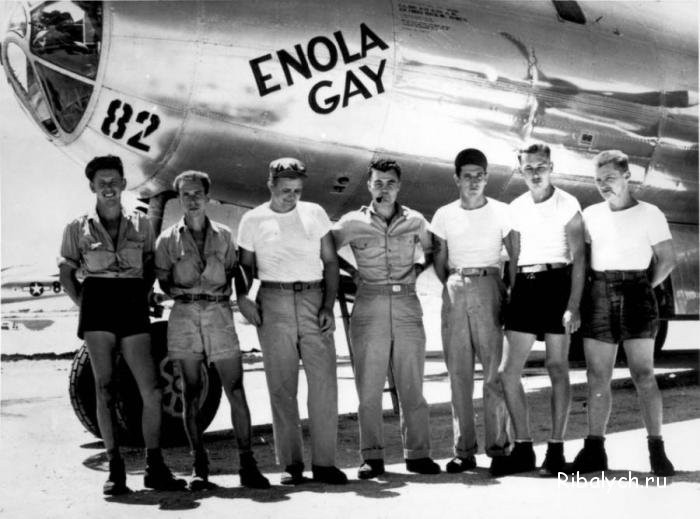
4. This image, provided by the US Air Force, shows the main team of the B-29 bomber Enola Gay, which dropped the Malysh nuclear bomb on Hiroshima on August 6, 1945. Pilot Colonel Paul W. Tibbets stands in the center. Photo taken in the Mariana Islands. This was the first time nuclear weapons were used during hostilities in the history of mankind.
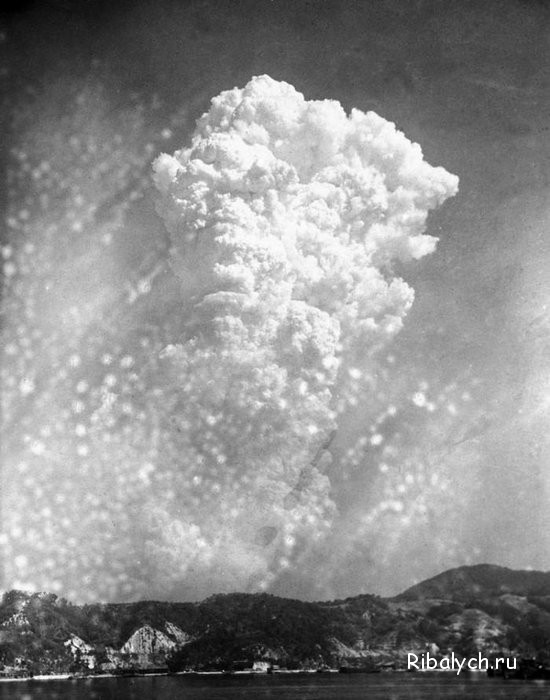
5. Smoke rising 20,000 feet above Hiroshima on August 6, 1945 after an atomic bomb was dropped on it during hostilities.
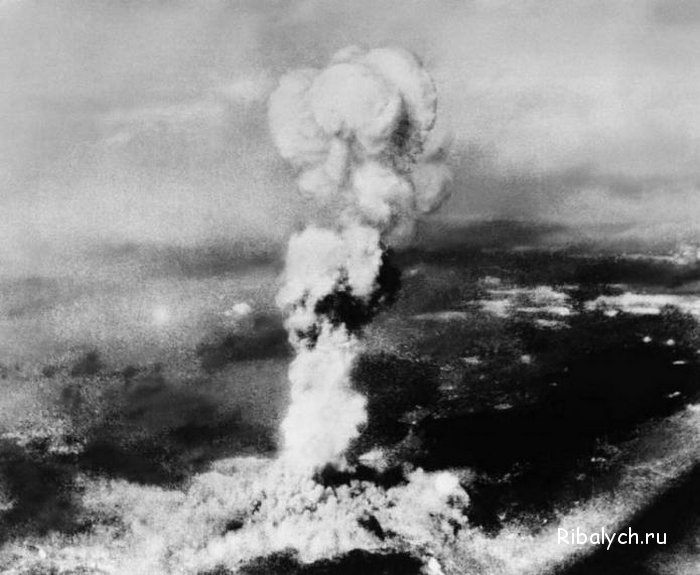
6. This photograph, taken on August 6, 1945, from the city of Yoshiura, on the other side of the mountains north of Hiroshima, shows the smoke rising from the atomic bomb in Hiroshima. The picture was taken by an Australian engineer from Kure, Japan. The radiation stains left on the negative nearly destroyed the image.
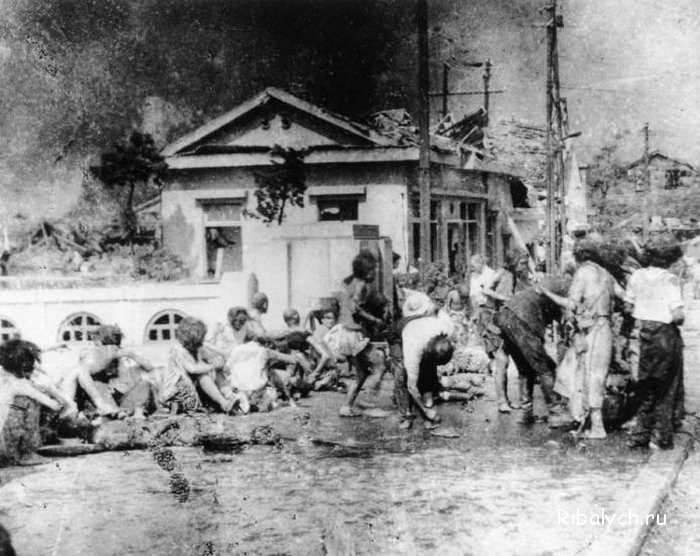
7. Survivors after the explosion of the atomic bomb, first used during hostilities on August 6, 1945, await medical care in Hiroshima, Japan. As a result of the explosion, 60,000 people died at the same time, tens of thousands died later due to radiation.
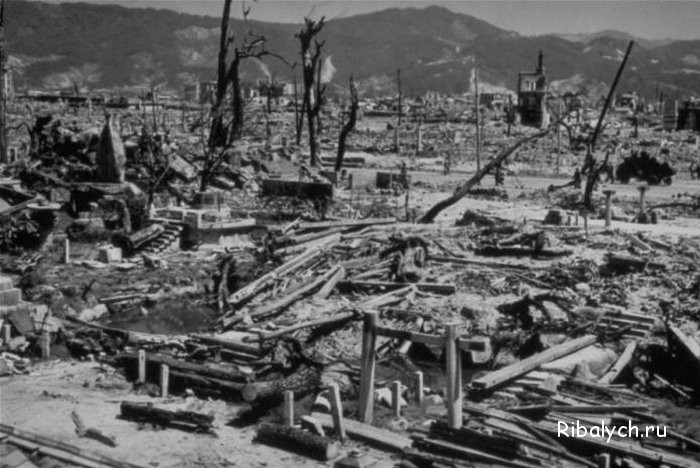
8. After the explosion of the atomic bomb on August 6, 1945, only ruins remained in Hiroshima. Nuclear weapons were used to hasten Japan's surrender and complete the Second world war, for which US President Harry Truman gave the order to use nuclear weapons with a capacity of 20,000 tons of TNT. The surrender of Japan took place on August 14, 1945.
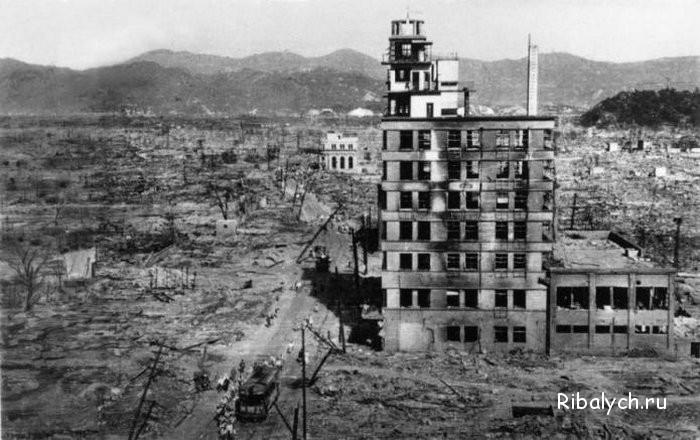
9. The skeleton of a building among the ruins on August 8, 1945, Hiroshima. Even the passport of the industrial pipe did not provide for such loads, nevertheless, some structures survived.
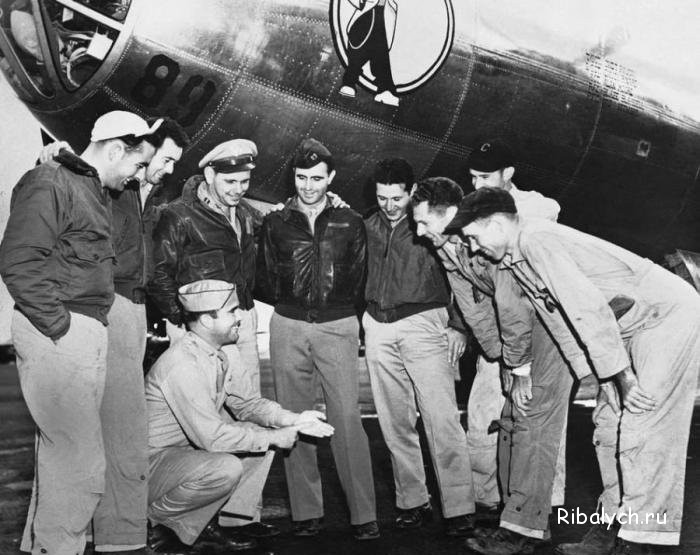
10. Crew members of the B-29 bomber "The Great Artiste", which dropped the atomic bomb on Nagasaki, surrounded Major Charles W. Swinney in North Quincy, Massachusetts. All crew members took part in the historic bombing. Left to right: Sergeant R. Gallagher, Chicago; Staff Sergeant A. M. Spitzer, Bronx, New York; Captain S. D. Albury, Miami, Florida; Captain J.F. Van Pelt Jr., Oak Hill, West Virginia; Lieutenant F.J. Olivi, Chicago; Staff Sergeant E.K. Buckley, Lisbon, Ohio; Sergeant A. T. Degart, Plainview, TX; and Sergeant Sergeant J. D. Kukharek, Columbus, Nebraska.

11. This photograph of the atomic bomb that exploded over Nagasaki, Japan during World War II was released by the Atomic Energy Commission and the US Department of Defense in Washington on December 6, 1960. The Fat Man bomb was 3.25 meters long and 1.54 meters in diameter, and weighed 4.6 tons. The explosion power reached about 20 kilotons in TNT equivalent.
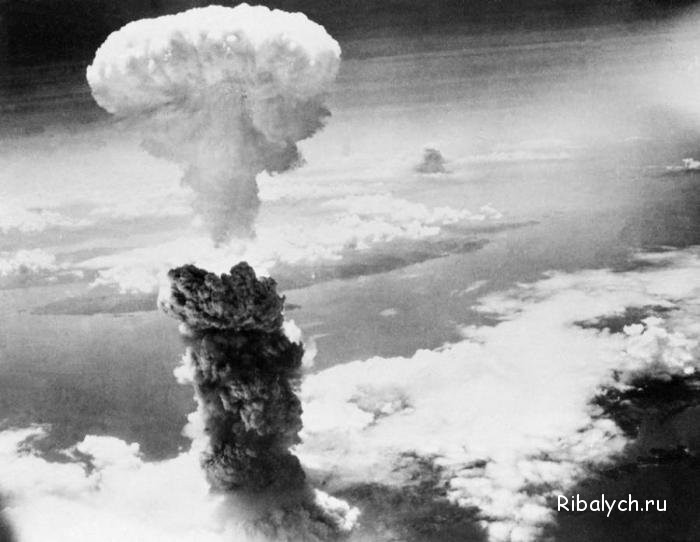
12. A huge column of smoke rises into the air after the explosion of the second atomic bomb in the port city of Nagasaki on August 9, 1945. As a result of the explosion of a bomb dropped by a bomber of the US Air Force B-29 Bockscar, more than 70 thousand people immediately died, tens of thousands more died later as a result of radiation.
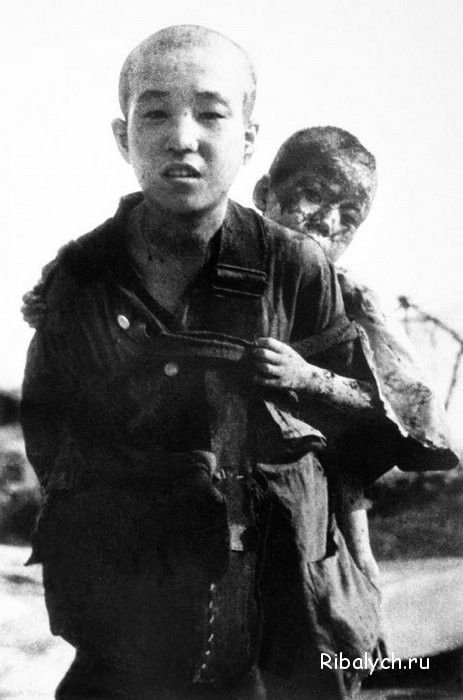
13. A boy carries his burned brother on his back, August 10, 1945 in Nagasaki, Japan. Such photos were not released by the Japanese side, but after the end of the war they were shown to the world media by the UN staff.
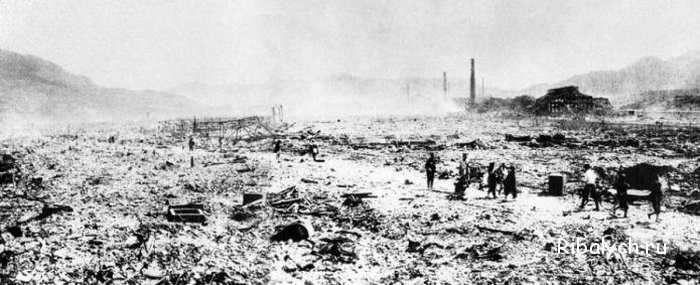
14. Japanese workers clear debris in the affected area in Nagasaki, an industrial city located in the southwest of Kyushu island, after the atomic bomb was dropped on it on August 9. A chimney and a lonely building are visible in the background, and ruins in the foreground. Photo taken from the archives of the Japanese news agency Domei.

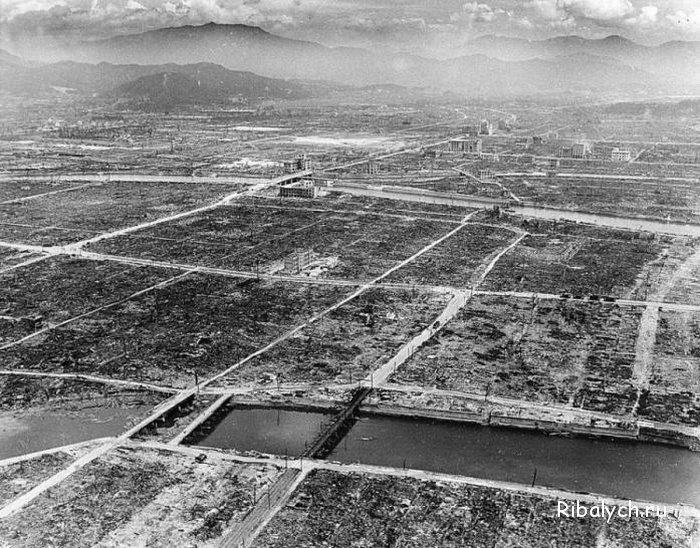
16. As you can see in this photo, which was taken on September 5, 1945, several concrete and steel buildings and bridges remained intact after the United States dropped an atomic bomb on the Japanese city of Hiroshima during World War II.

17. Most of the territory of Hiroshima was razed to the ground by the explosion of the atomic bomb. This is the first aerial photograph after the explosion, taken on September 1, 1945.
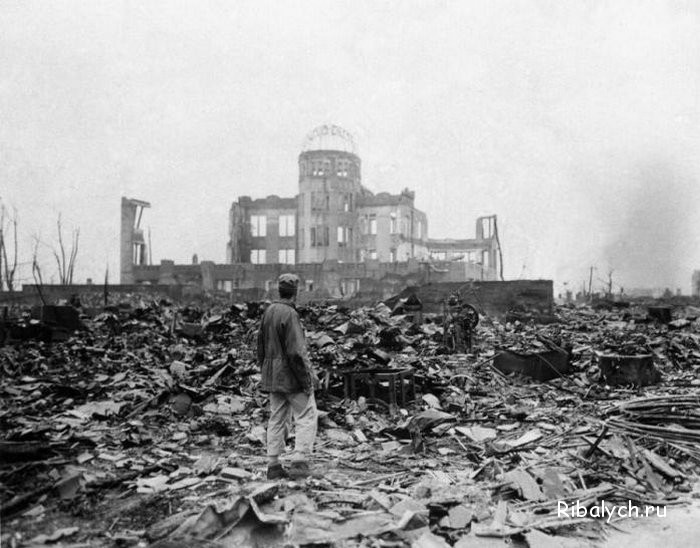
18. A reporter stands amid the ruins in front of the skeleton of a building that was a city theater in Hiroshima on September 8, 1945, a month after the first atomic bomb was dropped by the United States to hasten Japan's surrender.

19. Very few buildings remain in the devastated Hiroshima, a Japanese city that was destroyed to the ground by an atomic bomb, as seen in this September 8, 1945 photograph. (AP Photo)
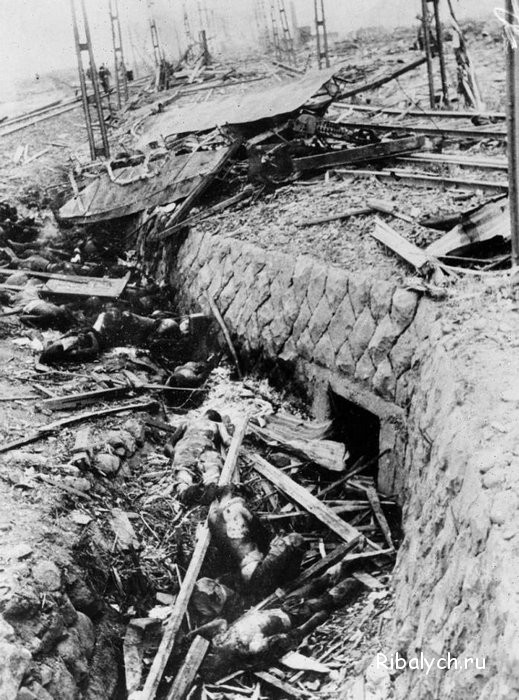
20. A tram (top center) and its dead passengers after a bomb blast over Nagasaki on August 9. Photo taken on September 1, 1945.

21. Catholic cathedral Urakami in Nagasaki, photographed on September 13, 1945, was destroyed by an atomic bomb.
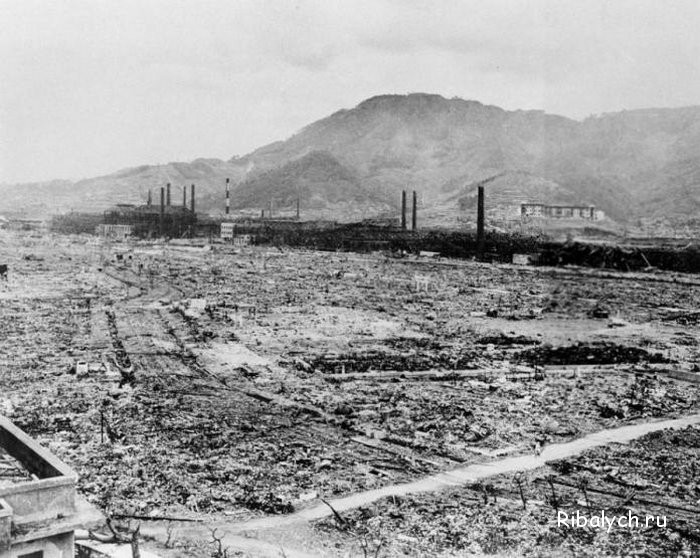
22. This area of Nagasaki was once built up with industrial buildings and small residential buildings... The ruins of the Mitsubishi factory and the concrete school building at the foot of the hill are visible in the background.
![]()
23. The top image shows the bustling city of Nagasaki before the explosion, and the bottom one shows the wasteland after the atomic bomb. The circles measure the distance from the blast point.

24. The sacred Torii gate at the entrance to a completely destroyed Shinto shrine in Nagasaki in October 1945.

25. Ikimi Kikkawa shows his keloid scars after healed burns from the atomic bomb blast in Hiroshima at the end of World War II. Photo taken at the Red Cross Hospital on June 5, 1947.

26. Pilot Colonel Paul W. Tibbets waves from the cockpit of his bomber at a base on Tinian Island on August 6, 1945, before taking off to drop the first ever atomic bomb on Hiroshima, Japan. The day before, Tibbets had named the B-29 flying fortress "Enola Gay" after his mother.
At the same time, on the other side of the earth:
REPORT
H-bomb
Checked by the teacher:
Kuzmina L.G.
Compiled by:
Medov M.M.
student 9 "b"
MOU SOSH №10
A HYDROGEN BOMB, a weapon of great destructive power (of the order of megatons in TNT equivalent), the principle of which is based on the reaction of thermonuclear fusion of light nuclei. The source of the explosion energy are processes similar to the processes taking place in the Sun and other stars.
In 1961, the most powerful explosion hydrogen bomb.
On the morning of October 30 at 11 h. 32 min. over Novaya Zemlya in the area of Guba Mityusha at an altitude of 4000 m above the land surface was blown up H-bomb with a capacity of 50 million tons of TNT.
The Soviet Union tested the most powerful thermonuclear device in history. Even in the "half" version (and the maximum power of such a bomb is 100 megatons), the explosion energy tenfold exceeded the total power of all explosives used by all the warring parties during the Second World War (including the atomic bombs dropped on Hiroshima and Nagasaki). The shock wave from the explosion circled three times Earth, the first time - in 36 hours 27 minutes.
The light flash was so bright that, despite the overcast, it was visible even from the command post in the village of Belushya Guba (almost 200 km away from the epicenter of the explosion). The mushroom cloud has grown to a height of 67 km. By the time of the explosion, while the bomb was slowly descending from a height of 10,500 to the calculated detonation point on a huge parachute, the Tu-95 carrier aircraft with its crew and its commander, Major Andrei Yegorovich Durnovtsev, was already in the safe zone. The commander was returning to his airfield as a lieutenant colonel, Hero of the Soviet Union. In an abandoned village - 400 km from the epicenter - wooden houses were destroyed, and stone houses lost their roofs, windows and doors. For many hundreds of kilometers from the landfill, as a result of the explosion, the conditions for the passage of radio waves changed for almost an hour, and radio communications were interrupted.
The bomb was developed by V.B. Adamsky, Yu.N. Smirnov, A.D. Sakharov, Yu.N. Babaev and Yu.A. Trutnev (for which Sakharov was awarded the third medal of the Hero of Socialist Labor). The mass of the "device" was 26 tons; a specially modified Tu-95 strategic bomber was used for its transportation and discharge.
"Superbomb", as A. Sakharov called it, did not fit in the bomb compartment of the aircraft (its length was 8 meters, and its diameter was about 2 meters), therefore the non-power part of the fuselage was cut out and a special lifting mechanism and a device for mounting the bomb were mounted; while in flight, it still stuck out more than half. The entire body of the aircraft, even the blades of its propellers, was covered with a special white paint that protects against a flash of light in an explosion. The same paint was applied to the hull of the accompanying laboratory aircraft.
The results of the explosion of the charge, which received the name "Tsar Bomba" in the West, were impressive:
* The nuclear "mushroom" of the explosion rose to a height of 64 km; the diameter of its cap has reached 40 kilometers.
The bursting fireball reached the ground and almost reached the bomb drop height (that is, the radius of the explosion fireball was approximately 4.5 kilometers).
* The radiation caused third-degree burns at a distance of up to one hundred kilometers.
* At the peak of emission of radiation, the explosion reached a power of 1% of the solar power.
* The shock wave from the explosion circled the globe three times.
* Ionization of the atmosphere caused radio interference even hundreds of kilometers from the landfill within one hour.
* Witnesses felt the impact and were able to describe the explosion at a distance of thousands of kilometers from the epicenter. Also, shock wave to some extent retained its destructive power at a distance of thousands of kilometers from the epicenter.
* The acoustic wave reached Dixon Island, where the blast wave knocked out windows in houses.
The political result of this test was the demonstration by the Soviet Union of possession of weapons of mass destruction unlimited in power - the maximum megatonnage of the bomb tested by the United States by that time was four times less than that of the Tsar Bomba. Indeed, the increase in the power of the hydrogen bomb is achieved by simply increasing the mass of the working material, so that, in principle, there are no factors preventing the creation of a 100 megaton or 500 megaton hydrogen bomb. (In fact, the Tsar Bomba was designed for a 100-megaton equivalent; the planned explosion power was cut in half, according to Khrushchev, "In order not to break all the glass in Moscow"). With this test, the Soviet Union demonstrated the ability to create a hydrogen bomb of any power and a means of delivering the bomb to the point of detonation.
The consequences of the explosion.
Shockwave and thermal effect. The direct (primary) effect of a superbomb explosion is threefold. The most obvious of the direct impacts is a shockwave of tremendous intensity. The strength of its impact, depending on the power of the bomb, the height of the explosion above the earth's surface and the nature of the terrain, decreases with distance from the epicenter of the explosion. The thermal effect of an explosion is determined by the same factors, but, in addition, it depends on the transparency of the air - the fog dramatically reduces the distance at which a thermal flash can cause serious burns.
According to calculations, when a 20-megaton bomb explodes in the atmosphere, people will remain alive 50% of the time if they
1) take refuge in an underground reinforced concrete shelter at a distance of about 8 km from the epicenter of the explosion (EE),
2) are located in ordinary city buildings at a distance of approx. 15 km from EV,
3) were in an open place, at a distance of approx. 20 km from EV.
In conditions of poor visibility and at a distance of at least 25 km, if the atmosphere is clear, for people in open areas, the probability of surviving increases rapidly with distance from the epicenter; at a distance of 32 km, its calculated value is more than 90%. The area over which the penetrating radiation that occurs during the explosion causes a lethal outcome is relatively small, even in the case of a high-yield superbomb.
Fallout.
How they are formed. When a bomb explodes, fire ball filled with a huge amount of radioactive particles. Usually, these particles are so small that, once in the upper atmosphere, they can remain there for a long time. But if a fireball touches the surface of the Earth, everything that is on it turns into red-hot dust and ash and draws them into a fiery tornado. In a vortex of flame, they mix and bind with radioactive particles. Radioactive dust, except for the largest, does not settle immediately. The finer dust is carried away by the resulting explosion cloud and gradually falls out as it moves in the wind. Directly at the site of the explosion, radioactive fallout can be extremely intense - mainly coarse dust settling on the ground. Hundreds of kilometers from the explosion site and at farther distances, small but still visible ash particles fall to the ground. Often they form a cover that looks like fallen snow, deadly to anyone who happens to be nearby. Even smaller and more invisible particles, before they settle on the earth, can wander in the atmosphere for months or even years, going around the globe many times. By the time they fall out, their radioactivity is significantly weakened. The most dangerous is the radiation of strontium-90 with a half-life of 28 years. Its fallout is clearly seen throughout the world. By settling on foliage and grass, it enters the food chains, including humans. As a result, noticeable, although not yet dangerous, amounts of strontium-90 have been found in the bones of the inhabitants of most countries. The accumulation of strontium-90 in human bones is very dangerous in the long term, as it leads to the formation of bone malignant tumors.
Long-term contamination of the area with radioactive fallout. In the event of hostilities, the use of a hydrogen bomb will lead to immediate radioactive contamination of an area within a radius of approx. 100 km from the epicenter of the explosion. When a superbomb explodes, an area of tens of thousands of square kilometers will be contaminated. Such a huge area of destruction with a single bomb makes it a completely new type of weapon. Even if the super bomb does not hit the target, i.e. will not hit the object with shock-thermal effects, penetrating radiation and the radioactive fallout accompanying the explosion will make the surrounding space unsuitable for habitation. Such precipitation can last for days, weeks or even months. Depending on their quantity, the intensity of the radiation can reach lethal levels. A relatively small number of super bombs are enough to completely cover large country a layer of radioactive dust that is deadly to all living things. Thus, the creation of the superbomb marked the beginning of an era when it became possible to make entire continents uninhabitable. Even after a long time after the cessation of the direct impact of radioactive fallout, the danger will remain due to the high radiotoxicity of isotopes such as strontium-90. With food grown on soils contaminated with this isotope, radioactivity will enter the human body
January 16, 1963, in full swing cold war, Nikita Khrushchev told the world that Soviet Union possesses in its arsenal a new weapon of mass destruction - a hydrogen bomb. A year and a half earlier, the most powerful explosion of a hydrogen bomb in the world was made in the USSR - a charge with a capacity of over 50 megatons was detonated on Novaya Zemlya. In many ways, it was this statement by the Soviet leader that made the world aware of the threat of further escalation of the race. nuclear weapons: Already on August 5, 1963, a treaty banning nuclear weapons tests in the atmosphere, outer space and under water was signed in Moscow.
History of creation
The theoretical possibility of obtaining energy by thermonuclear fusion was known even before World War II, but it was the war and the subsequent arms race that raised the question of creating a technical device for the practical creation of this reaction. It is known that in Germany in 1944 work was carried out to initiate thermonuclear fusion by compressing nuclear fuel using conventional explosive charges - but they were not crowned with success, since it was not possible to obtain the required temperatures and pressures. The USA and the USSR have been developing thermonuclear weapons since the 40s, practically simultaneously testing the first thermonuclear devices in the early 50s.
On November 1, 1952, the United States blew up the world's first thermonuclear charge on Enewetok Atoll. On August 12, 1953, the world's first hydrogen bomb, the Soviet RDS-6, was detonated in the USSR at the Semipalatinsk test site.
The device, tested by the United States in 1952, was not actually a bomb, but a laboratory sample, a "3-storey house filled with liquid deuterium," made in a special design. Soviet scientists, on the other hand, developed precisely the bomb - a complete device suitable for practical military use.
The largest hydrogen bomb ever detonated - the Soviet 58-megaton "Tsar Bomb", detonated on October 30, 1961 at the archipelago range New earth... Nikita Khrushchev subsequently joked publicly that it was originally supposed to detonate a 100-megaton bomb, but the charge was reduced "so as not to break all the glass in Moscow." Structurally, the bomb was really designed for 100 megatons and this power could be achieved by replacing the lead tamper with a uranium one. The bomb was detonated at an altitude of 4000 meters above the Novaya Zemlya test site. The shock wave after the explosion circled the globe three times. Despite a successful test, the bomb did not enter service; nevertheless, the creation and testing of the superbomb had a great political significance, demonstrating that the USSR has solved the problem of achieving practically any level of megatonnage of the nuclear arsenal.
How the hydrogen bomb works
The action of a hydrogen bomb is based on the use of energy released during the reaction of thermonuclear fusion of light nuclei. It is this reaction that takes place in the interiors of stars, where, under the action of ultra-high temperatures and gigantic pressure, hydrogen nuclei collide and merge into heavier helium nuclei. During the reaction, part of the mass of hydrogen nuclei turns into a large amount of energy - thanks to this, the stars release great amount energy constantly. Scientists copied this reaction using the isotopes of hydrogen - deuterium and tritium, which gave the name "hydrogen bomb". Initially, liquid hydrogen isotopes were used for the production of charges, and later lithium-6 deuteride, a solid, a compound of deuterium and a lithium isotope, began to be used.
Lithium-6 deuteride is the main component of the hydrogen bomb, a thermonuclear fuel. It already stores deuterium, and the lithium isotope serves as a raw material for the formation of tritium. To start the thermonuclear fusion reaction, it is required to create high temperature and pressure, and also to isolate tritium from lithium-6. These conditions are provided as follows.
The shell of a container for a thermonuclear fuel is made of uranium-238 and plastic, a conventional nuclear charge with a capacity of several kilotons is placed next to the container - it is called a trigger, or a charge-initiator of a hydrogen bomb. During the explosion of a plutonium charge-initiator under the action of powerful X-ray radiation, the shell of the container turns into plasma, contracting thousands of times, which creates the necessary high pressure and tremendous temperature. Simultaneously, neutrons emitted by plutonium interact with lithium-6 to form tritium. Deuterium and tritium nuclei interact under the action of ultrahigh temperature and pressure, which leads to a thermonuclear explosion.
If you make several layers of uranium-238 and lithium-6 deuteride, then each of them will add its own power to the explosion of the bomb - that is, such a "puff" allows you to increase the power of the explosion almost indefinitely. Thanks to this, a hydrogen bomb can be made of almost any power, and it will be much cheaper than a conventional one. nuclear bomb the same power.
The other day, the DPRK officially announced successful test a hydrogen bomb that caused an earthquake near the nuclear test site.
According to the North Korean leadership, they tested only a "miniature" version of the weapon.
AFP analyzed the mechanism of the hydrogen bomb.
The bomb has two stages, and first explosive compresses a plutonium ball of the first degree and transfers it to a supercritical state, after which a fission chain reaction begins. The reactions in the first stage heat up the second, which puts the plutonium rod into a supercritical state, which causes the release a large number heat.
As a result chain reactions in a bomb, its action leads to dangerous consequences: fallout, shockwave, heat effect and fireball.
What is a hydrogen bomb?
The hydrogen bomb is thermo nuclear weapons more destructive than nuclear weapons. The source of energy are processes similar to those taking place on the Sun. Thanks to its mechanism of action, the power of a hydrogen bomb can be increased by the desired number of times. In addition, its production is cheaper than atomic bombs of the same power.
The consequence of the explosion of a hydrogen bomb is a shock wave of enormous intensity, the formation of giant self-sustaining fire hurricanes for several hours, and radioactive contamination of the area. The huge area affected by one bomb makes it a completely new type of weapon. Even if the superbomb does not hit the target, the penetrating radiation and the radioactive fallout accompanying the explosion will make the surrounding space uninhabitable for several months. A relatively small number of superbombs are enough to completely cover a large country with a layer of radioactive dust that is deadly to all living things. Thus, entire continents can be made uninhabited.
Operating principle
First, the detonation of the initiator charge located inside the HB shell (miniature atomic bomb) occurs, the result of which is a powerful emission of neutrons and the creation of high temperature required to start thermonuclear fusion in the main charge. Massive neutron bombardment of the lithium deuteride insert (obtained by combining deuterium with the lithium-6 isotope) begins. Under the action of neutrons, lithium-6 is split into tritium and helium.
The atomic fuse in this case becomes a source of materials necessary for the course of thermonuclear fusion in the detonated bomb itself. A mixture of tritium and deuterium triggers a thermonuclear reaction, as a result of which the temperature inside the bomb rises rapidly, and more and more hydrogen is involved in the process.
The principle of operation of a hydrogen bomb implies an ultra-fast course of these processes (the charging device and the layout of the main elements contribute to this), which seem instantaneous to the observer.




